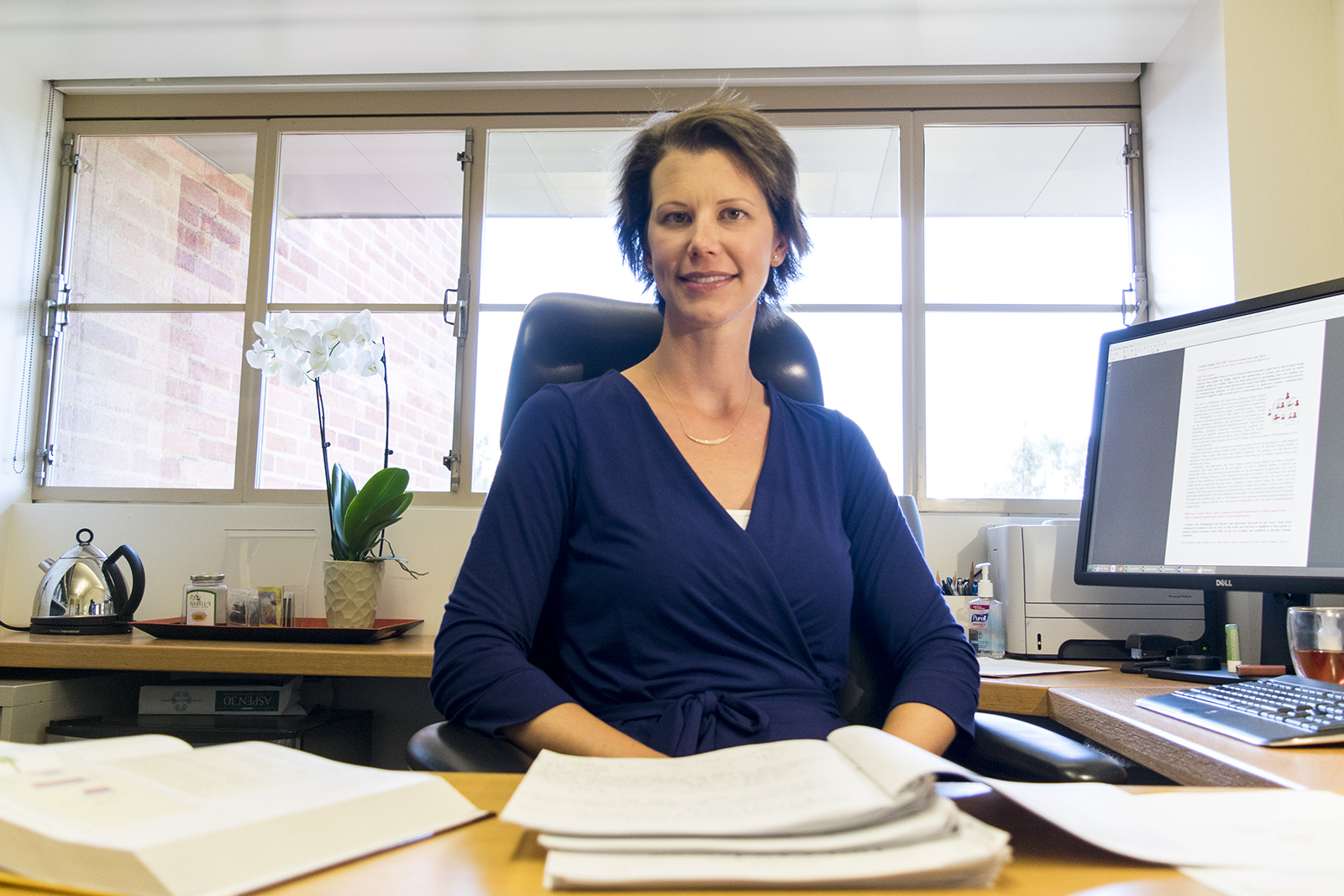Diagnosis motivates assistant professor to conduct breast cancer research

Elisa Long, an assistant professor at the UCLA Anderson School of Management, conducted research about the cost-effectiveness of universal testing for breast cancer gene mutations. (Alejandra Reyes-Velarde/Daily Bruin senior staff)
By Jorge Valero
Sept. 3, 2015 5:24 p.m.
Elisa Long spent her six-hour, daily chemotherapy sessions last summer reclining in a hospital chair binge-watching “The Price is Right,” determined to learn the rules and tricks of the games.
She was a contestant on the show’s breast cancer awareness special in August, after completing a chemotherapy session the day before. Long said her statistical skills, coupled with sheer luck, helped her win two new cars and a Rodeo Drive shopping spree.
Long, an assistant professor of decisions, operations and technology management at the UCLA Anderson School of Management, was diagnosed last year with triple-negative breast cancer, the most aggressive form of the disease.
Long said her diagnosis motivated her to conduct original research on breast cancer, specifically mutations in the BRCA1 and BRCA2 genes, last March. Long, who has a doctorate in management science and engineering, collaborated with Dr. Patricia Ganz, director of the division of cancer prevention and control research at UCLA’s Jonsson Comprehensive Cancer Center. Their research was published Sept. 3 in JAMA Oncology.
They concluded universal testing in the U.S. for BRCA mutations is not cost-effective at current prices, Long said. Ganz added the most widely used BRCA genetic test today costs around $2,000 to $4,000.
Long and Ganz calculated the number of breast and ovarian cancers averted as a result of using a hypothetical universal BRCA testing program. Their results showed universal testing for BRCA mutations was not more effective in diagnosing breast or ovarian cancers than testing only people with a family history of those diseases.
BRCA1 and BRCA2 genes help repair damaged DNA. When a mutation is present in a BRCA gene, damaged cells are not properly repaired and are more prone to alterations that can lead to cancer, Long said.
Long carries the BRCA1 mutation, a hereditary mutation that affects one of 400 people, though her family does not have a history of breast cancer. BRCA1 and BRCA2 mutations account for around 5 to 10 percent of all breast cancers, according to the National Cancer Institute.
Ganz said she thinks mammography screenings for people over 50, as well as colon cancer screenings, are more effective and cost-efficient diagnostic tests. Long added she thinks she personally would have benefited tremendously from a universal screening program, but her genetic mutation makes her case a rare one.
“I had to ask myself if that money is better spent on other forms of testing that are more personalized to the particular patient,” Long said.
Long said her academic background in probability and choice became more important to her as a breast cancer patient. She poured over medical journals and talked to experts, trying to decide which path would give her the best chance of success.
Long decided to undergo chemotherapy treatment before the surgery, hoping to shrink the tumor and increase the chance of a successful surgery. She had six rounds of chemotherapy sessions every three weeks, each lasting 6 to 8 hours, which she said often left her feeling fatigued, nauseated and cold.
Her husband, Keith Chen, an associate professor of economics at the School of Management, accompanied Long throughout her treatment.
“Cancer made her focus her research more directly on the specific challenges she encountered during treatment, but it would have been hard for her to be more dedicated to questions of health care than she already was,” Chen said.
Long had a bilateral mastectomy – a surgery that removed all of both breasts – because her genetic mutation meant she had a higher likelihood of developing a new cancer after chemotherapy.
After four months of treatment, doctors informed Long that the chemotherapy had succeeded in killing all of her cancer cells, she said.
Long said she wants to focus her future research on helping patients make more informed decisions about treatments by using surveys to study what kind of surgery patients most commonly choose and whether they decide to do chemo or surgery first.
“(Patients) need to be able to make their own decisions based on the best information they can get, but many don’t even know what kind of questions to ask their doctors,” Long said.
People with triple-negative breast cancer who do not undergo unsuccessful chemotherapy have a three-year survival rate of 68 percent, Long said. People, including Long, whose treatments are successful, have a three-year survival rate of 94 percent.
Long said her mindset while a contestant on the show paralleled her approach to her cancer treatment.
“I had to make the best choice I could with the hand I was dealt,” she said.

